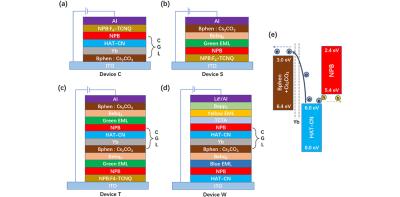Researchers from South China University of Technology and Guangzhou New Vision Opto-Electronic have found that the lifetime and current efficiency of a tandem OLED device can be greatly improved by adding an ultra-thin Ytterbium (Yb) metal layer through the charge generation layer (CGL).
The experiments detail an ultra-thin Yb metal layer with low work function, high transmittance, and large atomic radii, added to a light-green tandem OLED devices. The new device exhibited a lifetime of 308 hours (T90) at an initial brightness of 10,000 cd/m2 - which is 362 times (!) longer than that of a similar device without the Yb layer (T90 = 0.85 hours). The lifetime of the same material in a single-layer configuration (not a tandem device) was 49 hours (T90).
The tandem OLED devices with the Yb layer can achieve a maximum current efficiency (CEmax) of 113.5 cd/A and a maximum power efficiency (PEmax) of 68.6 lm/W, which are 2.3 times and 1.28 times higher, respectively, compared to those achieved by a single-unit OLED (not a tandem devices).
The researchers explain that the insertion of the Yb metal layer promotes the injection of electrons and can well curb the performance degradation caused by the diffusion of the two materials at this interface, thereby greatly improving the device lifetime.


